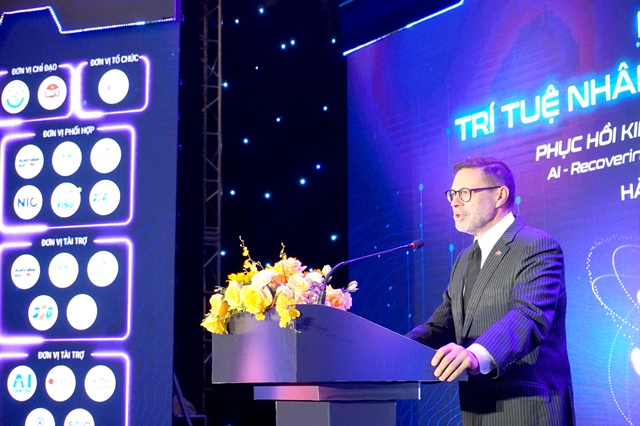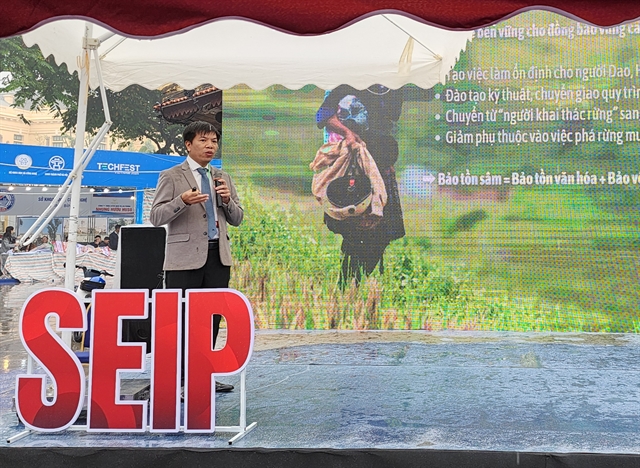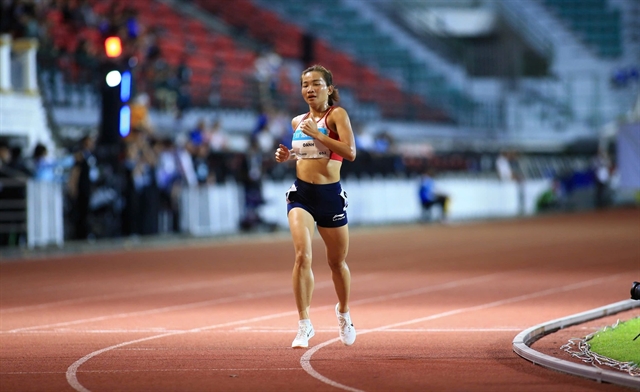 Politics & Law
Politics & Law

 |
| Australia’s Ambassador to Việt Nam, Andrew Goledzinowski (left) talks with Việt Nam News reporter Ollie Arci. VNS Photo Minh Phương |
As Việt Nam and Australia prepare to celebrate the 50th anniversary of diplomatic ties next year, the partnership is going from strength to strength, with excellent relations developed across a broad spectrum of sectors. Australia's new Ambassador to Việt Nam, Andrew Goledzinowski, speaks to Việt Nam News reporter Ollie Arci about current initiatives and what the future holds for this fruitful and productive relationship.
It's been a month since you arrived here. How are you finding Việt Nam? What are your impressions? How are you settling in?
To tell you the truth, my head is still spinning. It's only been four weeks, but a lot has happened in those four weeks. Importantly, our personal effects arrived just last Friday. So, the house is a mess, but gradually we will start to make it feel like a home. But we've been very warmly received here in Việt Nam.
I'm not a stranger to the country. I've been here many times before, including as a tourist. And I know Southeast Asia a little bit. My last posting was in Malaysia. And immediately before here, I was in charge of the Southeast Asia Regional Division. I'm familiar with the environment. I'm looking forward to doing a lot of travel.
I've already had a chance to get down to HCM City twice. I've been to Vũng Tàu, I've been to Cần Thơ. I'll be in Đà Nẵng, I think it's next week. So, you know, it's great to get out of Hà Nội to meet people, enjoy the food.
One thing I've noticed is the coffee, the quality of the coffee in Hà Nội is fantastic. There's some really first-class little hipster coffee shops, which I'm enjoying very much.
This month marks the one-year anniversary of the ASEAN-Australia Comprehensive Strategic Partnership (CSP). How do you see this partnership enhancing cooperation between Australia and ASEAN, and how does that fit into the ASEAN Outlook for the Indo-Pacific region?
It's absolutely key for us. The Indo-Pacific is our region, and at the heart of that is ASEAN. It really is incredibly important for our foreign policy. And I would say it's becoming more important, particularly at a time when the world is in an uncertain place. The region is an uncertain place with competition growing.
It's important that ASEAN holds the centre. It's important that we maintain our balance in this part of the world and that we underline the importance of the rules-based order and respect for sovereignty and independence. That's one of the reasons Việt Nam is so important for Australia at this time.
It's always been important, and trade is growing very well. But the big picture for us is to make sure that countries like Australia and Việt Nam work together well within the ASEAN context to try and maintain peace and security in our region. So we were very proud to be ASEAN's first comprehensive strategic partner. Just as a generation ago, we were the first dialogue partner for ASEAN.
How we're implementing it is there's A$154 million that we've committed to a new initiative, which is the Australia for ASEAN initiative. And that will allow us to do more work across a whole range of things – maritime issues, clean energy transition – all the things that people talk about.
There are also 100 new higher education scholarships there, and 350 technical and vocational education scholarships. So, there's a lot that's happening and there's a lot more that's going to be happening.
In terms of climate change, both Australia and Việt Nam have made significant commitments in this regard, particularly to reach net zero by 2050. How do you see the two countries working together for this target?
We have a similar dilemma in that we've both committed to net zero. It's going to be tough for Australia because we're a very energy-intensive country.
We are large, so we have big distances to cover. For Việt Nam, it'll be hard because it's important that it maintains its growth levels while also meeting these other commitments.
So, it's important that countries like ours work together. We have some similarities. We both have very long coastlines that will be impacted by climate change.
We're both quite fossil fuel intensive in our current economies but we're both moving towards sustainable energy futures. We're working with Việt Nam on that in a few different ways. We're doing some work in the regulatory and policy space. So our energy administration organisations are talking about carbon markets and competitive energy markets.
We are investing in some of Việt Nam’s sustainable energy projects. Last year, Australia invested in three onshore windfarms in Quang Tri as part of a consortium. We're talking to Việt Nam about offshore wind as well, which is very prospective in this country.
And we've also recently partnered with Vin around green cars, public transport and recharging facilities. So again, we're part of a consortium with the ADB and others, which is making all of that possible. So, when you see those green buses tearing around Hà Nội, think about Australia.
Việt Nam saw an increase in FDI due to these carbon emission targets. How can Việt Nam really take advantage of that position and the kind of inflow that's happening now?
I think Việt Nam has a good story to tell and it has to tell it well.
Việt Nam, I think is probably the most exposed of Southeast Asian countries to international corporate FDI. The Vietnamese growth model up until now has been reliant on those investments. And those investments now are very sensitive to issues of transition and carbon and sustainability.
I think Việt Nam has made the right decision at the right time. Now it's working hard to deliver on that. Partly, it's a matter of shifting the economy from being the sort of labour-intensive, export-oriented manufacturing economy to being one that moves further up the value curve.
And as it does that, the good thing is Australia will be at the top of that value curve, where we'll be able to participate more in Việt Nam's transition.
 |
| Ambassador Andrew Goledzinowski at AI Summit 2022, held in Hà Nội in September. Photo courtesy of the Australian Embassy |
In terms of that transition, what do you think about the progress Việt Nam has made in terms of science and technology?
I've been very impressed. In my very first week here after presenting credentials, I was at a conference with the Prime Minister about the commercialisation of innovation where Australia has some experience, which we are sharing.
The same day, I was in a half-day conference with one of the Deputy Prime Ministers on artificial intelligence. And again, we have some connection there. The impression I have is that this government is sincerely interested in innovation, which is important because I think they understand that over the next decade or so about a third of Việt Nam's jobs will be automated.
Việt Nam really has to move down that track. One of our flagship programmes with Việt Nam is called Aus4Innovation. Under which, we are doing all sorts of projects jointly between our government agencies and between our universities. As I said in the conference about commercialising innovation, I said this to the Prime Minister, Australia has science teams in only three embassies around the world – Washington, Singapore, and Hà Nội.
The good news is we've decided to extend Aus4Innovation to 2027, so that'll make it a 10-year programme.
You mentioned that the Government has acknowledged the vital role of science and technology and there is a strategy for science, technology and innovation. What is Australia's approach to supporting this innovation ecosystem?
We have a really good relationship with the ministry of science and technology, and the minister is the minister I've met most.
We are doing a lot and we want to do more. For example, you mentioned Việt Nam's innovation strategy to 2030. We participated in the development of that strategy.
We've also been cooperating in the dissemination of Việt Nam's AI. At one of the conferences I attended, I was able to see some of the actual work that we are doing which is fascinating. Some of it is using remote sensors and satellites and interconnectedness, the internet of things, to allow Vietnamese experts to monitor the health of forests and natural environments.
There's another one that's using similar technologies to allow farmers in the south to monitor water quality and that enables them to make better decisions about water use.
There's an awful lot out there that's going on and a lot of it doesn't get headlines. So, I appreciate the opportunity to mention these things. Another area, for example, is agriculture. We're both great agricultural nations. In Australia's case, Agritech is now a very serious business. So, we're working again with Vietnamese farmers and the Vietnamese government. I think it's up to A$15 million investment for low-carbon rice production in the south. There's a lot happening and there's a lot more happening. VNS




